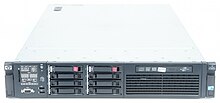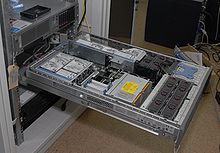| This article is missing information about additional details and history during the Compaq era. Please expand the article to include this information. Further details may exist on the talk page. (December 2023) |
 HP ProLiant DL380 G6 HP ProLiant DL380 G6 | |
| Developer | Compaq (1993-2002) Hewlett-Packard (2002-2015) Hewlett Packard Enterprise (2015-present) |
|---|---|
| Type | Tower, rack-mounted, or blade-based server |
| Release date | 1993 (Compaq ProLiant); 2003 (HP ProLiant); 2015 (HPE ProLiant) |
| CPU | Intel Atom, Intel Xeon, AMD Epyc |
| Power | Up to 2.2 kW dual hot-plug 4+0 PSUs |
| Marketing target | Business purpose |
| Predecessor | 1993 (Compaq): Compaq SystemPro XL (high-end) 2002 (HP acquisition): HP NetServer |
| Related | Integrity, BladeSystem |
| Website | HPE ProLiant Server | HPE |
ProLiant is a brand of server computers that was originally developed and marketed by Compaq, Hewlett-Packard (HP), and currently marketed by Hewlett Packard Enterprise (HPE). ProLiant servers were first introduced by Compaq in 1993, succeeding their SystemPro line of servers in the high-end space.
After Compaq merged with HP in 2002, HP retired its NetServer brand in favor of the ProLiant brand. HP ProLiant systems led the x86 server market in terms of units and revenue during first quarter of 2010. HPE now owns the ProLiant brand after HP split up into two separate companies in 2015.
The HP/HPE ProLiant servers offer many advanced server features such as redundant power supplies, Out-of-band management with iLO or Lights-out 100, Hot-swap components and up to 8-Socket systems.
History
 Wordmark of the ProLiant brand when it was still owned by Compaq
Wordmark of the ProLiant brand when it was still owned by Compaq


The ProLiant series of server computers was originally introduced in 1993 by Compaq to replace their former SystemPro line of servers in the high-end space, with the mid-range space of the SystemPro being succeeded by the ProSignia line of servers and business PCs. The ProLiant and ProSignia brand of servers coexisted with each other up until the ProSignia brand was discontinued in 2000.

On January 31, 2000, Compaq introduced the ProLiant ML and DL line of servers as part of a restructuring of its existing line of ProLiant servers into two separate and distinct lines to suit different needs in the server market. The ML (Modular Line) line of servers features a modular design that is designed for maximum system expansion, while the DL (Density Line) line of servers consists of powerful, density-optimized servers designed for rack mounted use. Though not officially labeled as such, this generation of ProLiant servers is also referred to as "Gen1". "Gen2" ProLiant servers were produced by Compaq from 2001 to 2002.
In May 2002, Compaq was acquired by HP. As part of the merger with Compaq that year, HP discontinued their NetServer line of servers that had been produced the same year ProLiant servers debuted in the early 1990s in favor of Compaq's ProLiant line of servers. The 2002 merger also brought in other products that were made or offered by Compaq at the time, such as the NonStop line of servers (which were formerly owned by Tandem Computers, inc. and then brought out by Compaq in 1997), the Presario line of personal computers, and the iPAQ line of personal digital assistant (PDA) devices.

Following the 2002 merger between Compaq and HP, "Gen2" ProLiant servers were produced by HP and replaced Compaq-provided software and tools with HP-provided ones. Throughout the rest of the 2000s up until the early 2010s, Gen3, Gen4, Gen5, Gen6, and Gen7 ProLiant servers were produced.
In February 2012, HP announced the ProLiant Gen8. In July 2013, HP announced a new blade server-based ProLiant, the HP Moonshot Server.
The ProLiant DL580 Gen8 has been described as a "middle generation" between Gen8 and Gen9. It has some of new features introduced in Gen9, primarily the availability of a UEFI boot option.
Starting August 28, 2014, HP ProLiant Gen9 series were available based on Intel Haswell chipset and DDR4 memory. The first were the HP ProLiant ML350 Gen9 Server and HP ProLiant BL460c Gen9 Blade. Servers in this generation support both BIOS and UEFI.
On November 1, 2015, HP split up into two separate companies, HP Inc., and HPE. As part of the spilt, HPE inherited the ProLiant line of servers from the original HP along with a few other products, such as the NonStop line of servers originally produced by Tandem Computers, Compaq, and the original HP.
Starting Q4 2017, HPE ProLiant Gen10 servers were available. Also in November 2017, HPE extended their Gen10 range to include AMD EPYC processors using EPYC's price v cores architectures claiming to lower cost per virtual machine (VM) by 50%.
In April 2021, HPE introduced the ProLiant Gen10 Plus line of servers, which are built on third-generation Intel Xeon scalable processors. Equipped with PCIe Gen4 capabilities, the HPE ProLiant DGen10 Plus servers offer improved data transfer rates and higher networking speeds.
In November 2022, HPE introduced the ProLiant Gen11 server lineup providing support for several architectures including fourth-generation AMD EPYC processors and fourth-generation Intel Xeon scalable processors.
In Q4 2024, HPE introduced the ProLiant Gen12 line of servers, featuring HPE and Nvidia's next-generation AI technologies. It features an NVIDIA GH200 NVL2 superchip with 1.2 TB of unified memory to accelerate AI workloads.
Details
ProLiant servers are separated into several different product lines - ML, DL, RL, SL, BL, SY, XL (Apollo), and MicroServer - which generally denote form factor.
ProLiant servers produced by Compaq includes tower-based and rack-mounted servers, which were produced in various different configurations and models. In 2000, the current ML and DL product lines were introduced. The ProLiant ML line comprises tower-based servers (convertible to rack mount) with capacity for internal expansion of disks and interconnects, while the DL line comprises general-purpose rack mount servers. Both the ProLiant ML and DL lines were inherited by HP (and HPE) after Compaq was acquired by HP in 2002.
The RL line compromises cloud-native servers that can handle cloud-native workloads, and the SL line compromises of rack mounted servers designed for use in data centers and environments where high computing power is required. The BL line comprises blade servers which fit within the HP BladeSystem, the SY line comprises Synergy Blades, and the XL line (also known as Apollo) comprises servers for scale out and High Performance Computing environments. The MicroServer product line addresses home and small businesses.
ProLiant servers are also split into several series which denote processor configuration. The 100, 200, 300 and 400 series comprise single and dual socket capable systems, the 500 and 600 series comprise quad socket capable systems, and the 700 and 900 series comprise eight socket capable systems. The 900 series supports up to 80 CPU cores and up to 4 TB of RAM. Models with a '0' in the last digit use Intel processors while models with a '5' in the last digit use AMD processors.
ProLiant servers made by Compaq were offered with the company's own SmartStart and Insight Management Agents, among other utilities. They were replaced with their HP equivalents after Compaq merged with HP in 2002. The ProLiant forms part of the HP Converged Systems, which use a common Converged Infrastructure architecture for server, storage, and networking products. Designed to support 50 to 300 virtual machines, the HP ConvergedSystem 300 is configured with ProLiant servers. A system administrator can manage ProLiant servers using HP OneView for converged infrastructure management. HP also provide drivers a software for managing servers such as Management Component Pack which includes hp online configuration utility (hponcfg), Agentless Management Service amsd, Smart Storage Administrator (SSA) ssa, Smart Storage Administrator (SSA) CLI ssacli and Smart Storage Administrator Diagnostic Utility (SSADU) CLI ssaducli.
Product lines

| Model | Product generation | |||||||||||
|---|---|---|---|---|---|---|---|---|---|---|---|---|
| 1 | 2 | 3 | 4 | 5 | 6 | 7 | 8 | 9 | 10 | 11 | 12 | |
| DL and RL series | ||||||||||||
| DL20 | ||||||||||||
| DL60 | ||||||||||||
| DL80 | ||||||||||||
| DL100 | ||||||||||||
| DL120 | ||||||||||||
| DL140 | ||||||||||||
| DL145 | ||||||||||||
| DL160 | ||||||||||||
| DL165 | ||||||||||||
| DL180 | ||||||||||||
| DL185 | ||||||||||||
| DL320 | ||||||||||||
| DL325 | ||||||||||||
| DL345 | ||||||||||||
| DL360 | ||||||||||||
| DL365 | ||||||||||||
| DL370 | ||||||||||||
| DL380 | ||||||||||||
| DL384 | ||||||||||||
| DL385 | ||||||||||||
| DL560 | ||||||||||||
| DL580 | ||||||||||||
| DL585 | ||||||||||||
| DL740 | ||||||||||||
| DL760 | ||||||||||||
| DL785 | ||||||||||||
| DL980 | ||||||||||||
| DL1000 | ||||||||||||
| DL2000 | ||||||||||||
| RL300 | ||||||||||||
Modular Line (ML)
ML server models are tower-based. They aim towards maximum expandability.
Density Line (DL) and RISC Line (RL)
DL server models are rack-based. They aim towards a balance between density and computing power.
RL server models are rack-based like DL server models, however they are designed to optimize cloud-native workloads as they are cloud-native servers.
Scalable Line (SL)
SL server models are rack-based. These models are mostly used in data centers and environments where a maximum of computing power is desired.
Blade Line (BL)
See also: HPE BladeSystemBL server models are enclosure-based. They are made specially for use in a blade enclosure and cannot be used without such. Blade systems aim towards maximum density and manageability at limited rack space.
There are two models of blade enclosures: HPE BladeSystem c3000 Enclosure (8 Bays for Blades), and HPE BladeSystem c7000 Enclosures (16 Bays for Blades).
One advantage of HP/HPE Blade Enclosures compared to competitors (such as IBM Blade Systems) has been that the older generation enclosures have been able to accommodate new generation BL servers just by upgrading the firmware for OA in the enclosure (Onboard Administrator). However improvements to back-plane of the enclosure in the new generation enclosures have enabled faster I/O capabilities (such as 10 Gbit/s Ethernet adapters and switches, and Infiniband). The physical design of the enclosures has not changed since the first versions (other than the larger LCD screen at the front compared to the first generation enclosures, and new plastic covers and HPE branding on the 3rd generation enclosures).
ProLiant MicroServer

The HPE ProLiant MicroServer line of products are entry-level, low power, compact, and affordable servers meant for small business, home office, or edge computing. They offer user upgradable components and easy access to hard drives. There is the option to purchase the server with ClearOS installed in order for users to be able to enable applications via an easy-to-use web-GUI with minimal effort.
See also
Notes
- Models produced by Compaq
- Models produced by Compaq (pre-merger) or HP (post-merger)
- Models produced by HP (pre-split) or HPE (post-split)
References
- "new hp industry standard server family". FAQ. HP. Archived from the original on October 16, 2013.
- Vassou, Andrea. "IDC Report Finds Worldwide Server Market Revenues Increase" Archived July 19, 2011, at the Wayback Machine "Tech Eye" May 27, 2010, retrieved May 27, 2010
- "ProLiant DL980 G7 Server - Overview". support.hpe.com. Retrieved August 12, 2020.
- "Compaq Delivers End-to-End Industry-Standard Servers and Services Portfolio for E-business". Compaq.com. January 31, 2000. Archived from the original on August 15, 2000. Retrieved November 27, 2024.
- "HP Accelerates Server Market Transformation with Self-sufficient HP ProLiant Gen8 Servers". Hewlett-Packard. February 13, 2012.
- "HP News: HP Unveils New ProLiant Gen9 Servers to Help Customers Address Evolving Data Center Demands". www8.hp.com. Retrieved September 16, 2020.
- "HPPSocialUserSignonPage - Hewlett Packard Enterprise Community". community.hpe.com. Retrieved September 16, 2020.
- Moorhead, Patrick. "HPE Goes Big With New Gen10 Servers". Forbes. Retrieved September 16, 2020.
- "HP ProLiant Server Models | Bargain Hardware".
- "Servers". hp.com.
- Rouse, Margaret. (2013-12). “Definition: Converged Infrastructure,” TechTarget.com.
- Morgan, Timothy Prickett. (April 29, 2013). “HP mashes up ProLiant, Integrity, BladeSystem, and Moonshot server business,” The Register.com.
- Tiano, Luigi. (September 28, 2013). “HP OneView Managing the Converged Infrastructure Data Center,” 1CloudRoad. Archived April 15, 2014, at the Wayback Machine
- "Drivers & Software - HPE Support Center". support.hpe.com. Retrieved September 16, 2020.
- "Servers - HPE Store US". buy.hpe.com. Retrieved September 16, 2020.
- ^ "Servers - HPE Store US". buy.hpe.com. Retrieved July 14, 2017.
- "HPE ProLiant Compute DL380a Gen12 - HPE". hpe.com. Retrieved December 10, 2024.
- "HPE ProLiant Compute DL384 Gen12 - HPE". hpe.com. Retrieved December 10, 2024.
- "View HPE ProLiant rack and tower servers - HPE". www.hpe.com. Archived from the original on July 28, 2017. Retrieved July 28, 2017.
External links
- Official website
- HPE QuickSpecs, a database of HPE product information provided by HPE
| Hewlett-Packard | |||||||||||||||
|---|---|---|---|---|---|---|---|---|---|---|---|---|---|---|---|
| Founders |  | ||||||||||||||
| Directors |
| ||||||||||||||
| Executive officers |
| ||||||||||||||
| Computer hardware products |
| ||||||||||||||
| Consumer electronics and accessories |
| ||||||||||||||
| Other divisions | |||||||||||||||
| Software | |||||||||||||||
| Discontinued products |
| ||||||||||||||
| Closed divisions | |||||||||||||||
| HP CEOs | |||||||||||||||
| Assets | |||||||||||||||
| See also | |||||||||||||||
| Compaq | |||||||||||||||||||||||
|---|---|---|---|---|---|---|---|---|---|---|---|---|---|---|---|---|---|---|---|---|---|---|---|
| |||||||||||||||||||||||
| Corporate aspects |
| ||||||||||||||||||||||
| Hardware |
| ||||||||||||||||||||||
| Software | |||||||||||||||||||||||
| |||||||||||||||||||||||